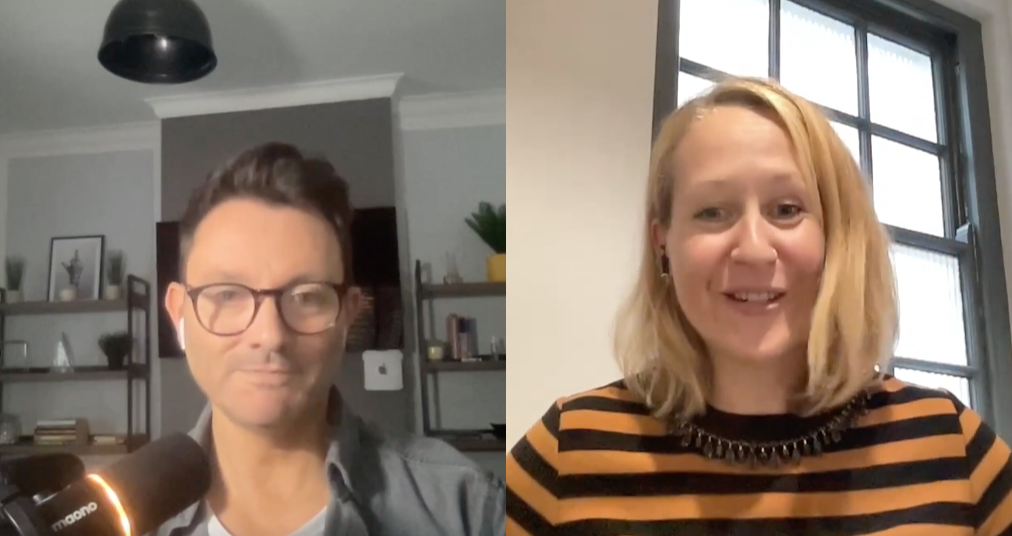
Read the full transcript here:
So there's an age old debate, which we've had many a time before, that your website can no longer be, and this has been happening for an age already, but your website cannot be an online brochure for your own. Well, isn't it more your website is much more than just a... Well, I don't... Isn't it that you can fucking do it then? The world of B2B marketing, sales and service tech is moving fast.
This podcast will cut through the hype, the hidden agendas and bullshit advice in search of the truth to help you make more informed decisions. Despite the importance and criticality of a website, there's still a lot of organizations that regard it as just an online brochure. And therefore what they do is every 18 months, two years may look at revamping the site. I do get that because ultimately, yeah, and we've, yeah.
We've done so many website projects over the year that you could understand that the pain and work and effort that goes into it. a lot of disruption. A lot of people think, thank fuck, that's done. We'll pause that, revisit it again later. And what happens during that process, maybe it's three to four month project, everything else goes on hold. We've got to wait till the website's live before we can do X, Y and Z. We've got to get the website live for this new event that's coming up.
We can't do anything else until that's there. And quite commonly we see that organizations, propositions, services, products evolve and it's very hard for them to keep up to date on the website, very hard for the website to keep pace with those changes. And you've just revamped your new website, you've done all your messaging, you've launched this new kind of brand online and then six months down the line, the proposition has changed so much that what you've got on your website, oop.
doesn't really reflect what you're actually selling to customers. that causes huge frustration. And it's not a quick fix. It's understandable, like you say. However, I think there's more things that are happening today that should mean that organizations do take this whole thing a lot more seriously and try and break this cycle of a two-year revamp of the website.
(02:23.374)
is ultimately that your website needs to be optimal and optimized at all times to make the most of the traffic that you do get. And I think there's lots of debates probably for another podcast around why web traffic may start to tail off. Obviously we've been through decades of investment in SEO, which overnight could be undone by AI ultimately.
You know, we see the proliferation of tools like ChatGBT. We see the integration of those tools within platforms that we already all use every day. HubSpot, et cetera. And now Google, as most people listening to this will have already experienced, whereby AI is serving up search results, whereby the answer to a question on page. Yeah, the answer is much more specific, much more accurate. to go to a website in order to answer that question for yourself.
And therefore, there's a question mark around SEO's effectiveness going forward. But the end result of that, whether that happens or not, is ultimately less traffic on the website. Which means you've got to do a lot more with the traffic that you get to the site. And of course, if you're going through a two-year revamp cycle, and for some it's even longer than that, at some point following that launch of the website, you'll... And in fact, if you want to think of it this way, the...
The value of that website is depreciating from the moment you turn it on until the moment you revamp it because it's getting more and more out of date with your proposition, as you mentioned, but it's also becoming more and more out of date with the needs of buyers. And again, probably for another podcast, but the needs of buyers we all know and most people listening to this will know have changed considerably over the last decade. And ultimately, buyers now want to
do more of that process for themselves? Self-service online. Yeah, and I think you just have to look at conversion rates. Even the best performers, conversion rates are still quite low when you think about how much traffic you get to a site and how much of that traffic you actually engage with. I think there's always been the call for better design, better UX.
(04:47.372)
And that's often one of the biggest thing, if not the biggest thing that will determine whether that initial kind of assessment of a site that's done soon, you know, that any visitor that goes to a new site, it's done in a few seconds. this site, or is this organization that I've now visited, are they in the category that I'm looking for? Are they legit? Are they credible? Are they high performers in that category?
And you can all get a feel for that. And there's no, every website you go to now, there's no kind of exception for a B2B company compared to a B2C company. And there used to be, there? There used to be. You'd accept it to be crap because it's a B2B company. It's not going to be like an Amazon experience. I'll get all the information I need from the salesperson.
But that's no longer the case. There's a sort of a general acceptance bar that you need to get to and still so many are way below that. So if you've got a combination of poor UX, poor design, if your proposition's not really articulated in the right way. And poorly enabled. There's no trust type content on the site. You're not credible. Any traffic you do get.
you're not going to convert. think in buyer enablement terms as well, there's limited ability for a buyer to continue that journey to a point whereby they're happy to then speak to the salesperson on your website, then they will be immediately put off. So if there isn't interactive elements, calculators, ways for them to determine pricing, ways for them to determine ROI, information about maybe some of the finer details.
Obviously we don't want war and peace web pages, they need to be able to reach a point in the sales process via a website that they never expected to be able to meet before. And if they can't do that, they will turn off. We talked about this with pricing so many times and there are debates around whether you should include pricing on your website and oftentimes it doesn't make sense. But for me, if I was buying a SaaS platform, for example,
(07:01.826)
And I went on one side, could see it's eight pound a user a month and another that said price and application or book a demo. I'm off it. I don't want to have to sit down and invest an hour in a demo with a prospect or with a salesperson only to find out it's out of my budget. this happened to me, as you know, this week we were investigating how to hire overseas various different vendors, provide those services, some of which provide
indicative pricing on their website, which is just what you need to get an initial assessment. Then others require you to engage with them. I engaged one of them with, it was Drift, I think they used. And straight away after that, I've then got, pinged an email and I'm just looking for some pricing. Don't worry about it. But then I've had about five, six different emails.
from them subsequently saying, and I've said I'm not interested, but they're just hounding me now. So that's a really outdated approach. A really outdated approach. I suppose to summarize what we've just said there, ultimately if you're not continually investing in your site, you are not able to keep up with the demands of buyers and the way people want to buy now. And that has changed, as we've just talked about. Additionally, as you said, you're not able to keep your site looking fresh, up-to-date, modern.
And that impacts the initial impression and we know first impressions are so important. So there's another dimension that comes into play here. So we've talked in previous podcasts about the move to a single platform and unifying the collaboration between marketing, sales and service. And all of that really is about engagement and customer experience. obviously at the heart of that is the website.
we need to move on generally from regarding the website as just this marketing platform that is only focusing on converting traffic into leads, into more self-service sales, into experience for existing customers. Can they find the information they need? Can you use the website to interact with them? And there's a recent example of content hub where we've created a
(09:22.484)
membership area effectively that enables existing customers via this by the website with the same look and feel to go beyond what is immediately accessible to the general public and access information which is very specific to them. So whatever quotes that are related to them that are outstanding what maybe they got some tickets open in the service hub maybe they've got you know documents and assets that they need to access as part of their relationship. So absolutely you're right that
The website is not just the center of the marketing activity, but it's used within all of the sales effort and equally, particularly when we have something in place like I've just mentioned, also the customer experience as a whole. Another way to think about this is if you think about all the investment you're making in marketing, all of the emails you're sending out, all the events you're doing, all the promotional work that you're doing.
80 % of that is directed at your website. Same with sales. As soon as someone is part of a sales process, they're going to probably be spending quite a lot of time on your website. Salespeople will be directing them to it. And in a customer service environment like the one I've just mentioned, they're also going to be spending a lot of time on the website. So if all of that investment is going into something, then ultimately, and the end point, the center point of all of that investment is the website.
then it makes no sense to deprioritize it. It makes no sense to undervalue the role that that website plays. the opportunity it brings in with all those interactions, the data that can be leveraged to create more personalized experiences for visitors when they come on through things like smart content, but also if the data sits in a very central, accessible form in CRM, it can then be leveraged by different teams.
The service team can, and we use this example lots of times, but we can alert service teams to potential issues through interactions through website. Opportunities can be identified by the service team to inform sales by interactions on the website. Lots of the data that is being generated and...
(11:42.752)
and obtained by those interactions can be better harnessed. But so often we just see the websites completely separate to all of that. And it's not able to sort of leverage the data that it can generate for a business. think the other dimension, there's many dimensions, but another dimension is the saturation of different channels that a lot of organizations rely on to engage with
new prospects. So LinkedIn is a good example. We know just how saturated that is. And I think there is naturally a call to move away from platforms that you don't own yourself to your own platform. And again, there's no better place than your website. And I think we are seeing more interest in organizations that maybe have got an audience or an existing community to focus their efforts now on making those interactions through the website as opposed to another platform or another channel that they don't own.
And that's another use case for HubSpot membership, so you mentioned earlier, absolutely. Ultimately, if you're going to be spending time and effort promoting your organization to a specific audience, then where better than to do that on a platform that you can try? And we've been trying to that for years, but think the investment that's gone into the website has not been enough to engage people to that level. But again, I think with all the other factors we talked about,
the use case for investing more in a website. It just grows stronger and stronger and stronger. So in your view, taking all that into account, how can organizations move forward with this? What should they embrace in terms of their approach that is more of a constant focus on the website as opposed to more of periodic approach? think it is a mindset shift and I think that has to happen. And obviously what comes with that
is the conversations around budget and allocation of resources to make this growth driven design approach work. what is that? for people that have never heard of Ultimately, it's building a website with the intention to continually iterate and improve. And as we talked about this at the start of this, that is very rarely the case. It is more of a cyclical build it, forget about it, rip and replace, build it, forget about it, rip and replace.
(14:06.85)
I think if organizations, marketing teams that are going to be central to the development of these websites. And service and sales that all should be involved too, All should be involved in the outset, but oftentimes it's going to be the marketing team that lead that development project. Start out with the intention to have a growth driven design approach and importantly communicate that internally to the powers that it be, but also to the other teams involved you mentioned service and sales.
then they're setting themselves up to be able to take that approach going forward, not only in their own minds to avoid that kind of, thank God that's done. I will leave that for a bit now. We'll focus on something else. But also so that they can secure the budget for a more continual development. Because I think the other thing that we haven't talked about is actually that's a more cost-effective way of working because you're ultimately- haven't got the big projects in two years time to-
front up. Incrementally improving your website over time which keeps it fresh, keeps it current, it keeps it in line with the needs of a particular buyer. And that extends the life of your website for a much longer period of time and ultimately requires less investment than maybe going through three rounds of complete rip and replace revisions of that website across the same period of time. It allows you to keep pace with the frequent changes and advances in UI as well.
new ways of interacting with people and even the just simple things, the way website loads, how the buttons interact, all of that is constantly evolving. And it's driven by the B2C sector really. Most of us subscribe to Netflix, but if you looked at Netflix three years ago in terms of its UI,
It'd be so drastically different than it is today. looks so dated. Your expectations as a consumer don't stop when you start to begin to deal with the B2B company. They're extended through that engagement. So your perspective of a website, even one that was built two years ago, if it hasn't changed, it's likely to be that it feels a bit dated and it feels a bit smelly.
(16:20.206)
That's driven by the constant innovation, constant refresh, constant growth driven approach that platforms in the B2B, a B2C sector take. I think aside from the fact that your website, maybe after an 18 month period, really doesn't reflect what you do as a business. The other big driver for organizations to say we need to update our website is because it's just fallen so far behind and it does look so dated and so smelly.
And if you take that kind of more incremental approach, you're going to avoid that. long period of time, you won't avoid it forever. Well, as long as you keep up those incremental developments to the side. But it does mean that it is more investment in having dedicated resources, having the right skill sets available, having, just like you say, the mindset where you can have a continual focus.
And you've got to maybe structure and develop the site in a way that enables you to make changes quite easily. Yeah. But I also think that if you're going to do that, you also need to bring structure into the way that you bring that growth driven design approach to the fore. So the random acts of what we also see, to be honest, and sometimes where websites are made even worse is when there's that kind of random act of marketing approach taken to it. So it may be a
an ambitious CEO, it may be a salesperson making requests that ultimately if you adhere to those requests over time and do them without thought, you will also end up with a really convoluted basket case difficult to navigate. Frankenstein's monster of a website. whilst we would definitely recommend that growth driven approach, it needs to have some guardrails. It needs to have a strategy. Yeah. Maybe you review
once every quarter, once every six months, once every year even, and have more of a consultation process around what incremental changes and improvements you want to make in a more structured way than the constant change in iteration that's unstructured, under thought through, and therefore ending up in a big smelly mess of a website. Yeah. I mean, I think there's sometimes you are going to inevitably face, like you say, a point where you have to invest.
(18:41.068)
not necessarily a whole scale revamp, but a fairly significant upgrade of the site. Because even if you're focusing on the core pages, the other pages, if they're left alone, they're going to quickly go out of date and you're going to have to shore that up at some point. But it's still a much better approach than having to do that really, really disruptive, complete overhaul and rebrand of your site on a sort two year basis. So I think if we were going to
finish off by giving some advice to the people listening to this. It is to really sit down and think about the next time that you embark on what is, as we know, quite a painful process to redevelop and redesign your website and start that process with the intention to not stop it as soon as the website project is done and the weight is lifted, but to start that project with the mindset that you will continually do this and you will continually do it within a structure that keeps
It keeps the random acts of marketing at bay, but still ensures that your website constantly evolves and continues to meet the needs of the people that are ultimately using it. It's breaking that mindset, isn't it? It's understandable once you've completed a big website project that you don't want to look at it again. just want to, you know, it's all done. It's gone live. Everyone's happy. I don't want to touch that thing again now because so much effort and so much attention has been placed on that whole thing over the last few months.
If you break the mindset, you won't have to go through that every two years. know, just, will, everything will even out, be a far more structured way of working and it will avoid those really painful moments that the website is the single biggest concern that you've got that's keeping you awake at night. I appreciate we just concluded this conversation, but there is one thing that we haven't talked about, which I think is important to add. And that's the website functionality these days, either platform
on which you host your website are also constantly evolving over time. I'll use HubSpot as an example, obviously, but HubSpot have released various elements of functionality related to what is now their content hub over the years that, you know, with a growth driven design approach, you can implement as and when they're available. I'm thinking of things like AI transcription for the blog. That requires an update to design.
(21:08.808)
in order for you to make the most of that new functionality that comes with your website platform. There's AI tools, there's personalization elements that are coming through and becoming available in the platforms that you use. And unless you're prepared to constantly iterate and develop that site, you're also not going to be able to make the most advantage out of those advancements in the tools that you subscribe to as well. Yeah, absolutely. Good. Good point. Well made. Yeah. Thanks. For once. Okay, we're done.
Things to listen out for:
0:30 - The pain of a website redesign project
2:30 - The impact of AI search on website traffic
4:16 - Why a B2B website must help buyers self-serve
5:57 - Reasons why websites don’t convert
8:45 - Why your website should support marketing, sales & service
9:30 - Exclusive communities, memberships & customer portals
11:05 - Leveraging CRM data for website personalisation
13:36 - The Growth-Driven Design (GDD) mindset
17:05 - How to implement a GDD strategy
20:40 - Why GDD enables quicker adoption of AI & new functionality



